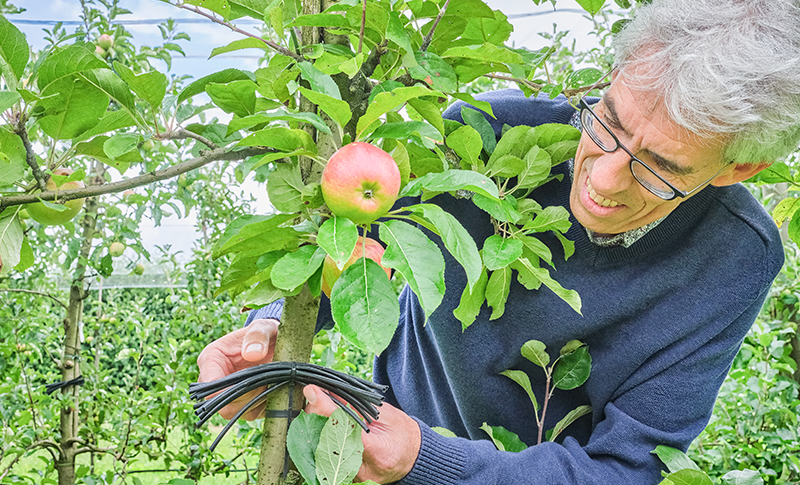The apple blossom weevil is wreaking havoc in Dutch orchards, leading to serious harvest losses. A simple piece of plastic could help, discovered researchers in Randwijk.
The harvest is poor in many Dutch apple orchards this year. The cause is a tiny proboscis weevil of barely six millimetres in length, which goes by the name of Anthonomus pomorum. The apple trees at Proeftuin Randwijk, the heart of Dutch fruit research, are no exception and are yielding a lot less fruit this year thanks to the apple blossom weevil. WUR researcher Herman Helsen estimates that there are less than half the usual number of apples on some plots.
The culprit is no newcomer to apple orchards. ‘Growers have been battling this weevil for as long as there have been apples,’ Helsen says. The apple blossom weevil strikes in spring. ‘For most of the year the weevil is inactive,’ Helsen explains. ‘Then it hides, under the bark of a tree for example. The weevil becomes active in the spring and lays its eggs in the flower bud. The flower then fails to open, and forms a capsule or casing around the larva. A new generation of weevils emerges in May, and the following year they start looking for flower buds.’
Catching by hand
Before the development of chemical pesticides, one way of catching the weevils was manually. According to Helsen, schoolchildren were often used for this. ‘In old French dictionaries you come across the word anthonomage, which means catching these Anthonomus weevils.
At one grower’s farm, there were 90 per cent fewer weevils
The insects would be shaken out of the trees and caught on a mat, where schoolchildren collected them.’ The discovery of the insecticide DDT just after the war was a breakthrough in pest control – with serious negative consequences for the rest of nature. Nowadays, chemical pesticides are only authorized occasionally.
In efforts to find natural remedies, a lot of research has been done into the use of ichneumon wasps, which lay their eggs in the weevil’s abdomen or in the casings around them. Helsen: ‘But you can’t get enough ichneumon wasps into an orchard to control the weevil adequately. The conditions that suit these parasitic wasps are actually ideal for the apple blossom weevil too. Parasitic wasps can play a role in controlling it, but you won’t solve the problem with them.’
Breakthrough
But there has now been some success in the fight against the weevil. Helsen goes so far as to call it a breakthrough. ‘A breakthrough in the sense that it enables us to get rid of more than half the weevils with non-chemical substances.’ The finding dates back to a more or less accidental discovery 15 years ago. Helsen and a colleague of his at the time wondered where apple blossom weevils overwinter.
Growers have been battling this weevil for as long as there have been apples
‘Normally, weevils often hide in tree bark. But in an orchard, the apple trees don’t get old enough to develop rough bark. Their trunks are smooth, so the weevil looks for a different hiding place. When my colleague was pruning, he happened to cut through a plastic strap used to attach fruit trees to posts. And we saw a weevil inside the hollow plastic cord.’ That observation gave Helsen the idea of hanging bundles of the ties in the trees to lure the weevils away.
‘We started testing various other materials as well,’ he says. ‘But these ties turned out to work best. You hang up bunches of ties in the summer and in the winter, you take them inside and put them in a plastic bag or in the cold store until the weevils are dead. In the spring, you can use those bunches again.’ In large-scale field trials at organic growers, there were big catches. ‘At one grower’s farm, there were 90 per cent fewer weevils in the treated fields than in the control ones.’
Cool spring
But the battle is not won yet, partly because some of the weevils overwinter outside the orchard. Overall, the apple blossom weevil population is still growing, and this has been a problematic boom year.
Parasitic wasps can play a role in control, but you won’t solve the problem with them
Helsen thinks the cool spring could account for the spike. ‘The cool weather slowed down the development of the apples. That gave the weevils longer to lay eggs. Another factor is that this year, unlike previous years, the government did not grant an exemption for growers to use Raptol, an insecticide based on pyrethrum from chrysanthemums.’
Meanwhile, Helsen is busy with preparations for applying the new method. ‘This is a prototype, but there is still plenty to work on. For example, which properties of the material are important? Is it the diameter or the colour? What effect does transparency have? How high up the tree should you hang the bundles?’ A handful of organic growers are already applying the prototype on their farms to reduce the weevil population pressure. But Helsen still foresees obstacles ahead. Although the solution is low-tech in itself – so low-tech, in fact, that it cannot be patented – it still costs money. Helsen: ‘It is labour-intensive to make and hang up those bundles. One on each tree, three thousand trees per hectare – just do the maths. Even if you pay the minimum wage, you can easily spend a few thousand euros per hectare. We are therefore also exploring the potential for mechanized production of the bundles and faster ways of hanging them up.’

 Herman Helsen: ‘It turns out the apple blossom weevil likes to hide in the material we use to tie apple trees to posts.’ Photo Guy Ackermans
Herman Helsen: ‘It turns out the apple blossom weevil likes to hide in the material we use to tie apple trees to posts.’ Photo Guy Ackermans